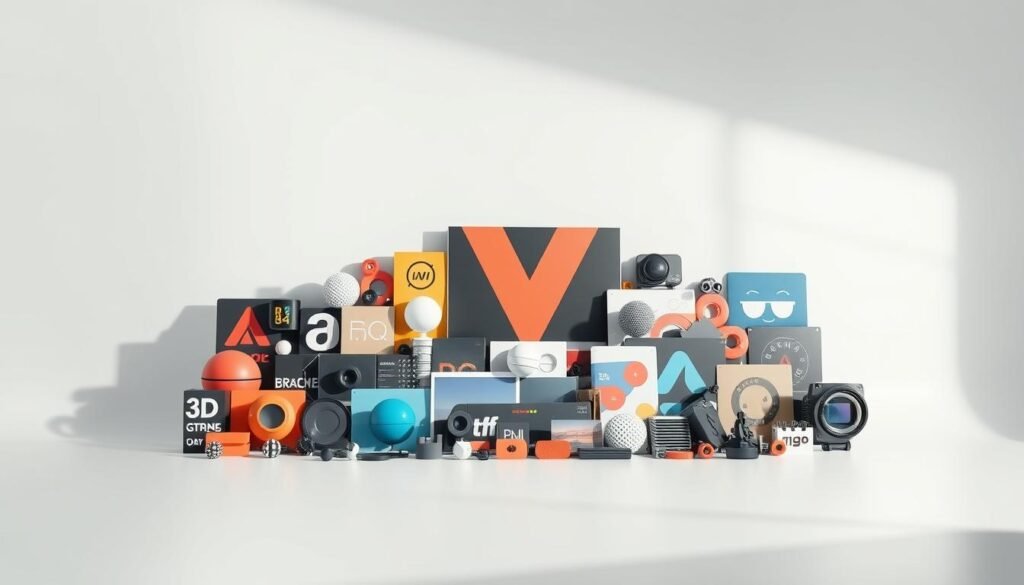Setting the right price for your services as a freelancer can be tough. You’re not alone in trying to earn more without scaring off clients. The secret is to grasp the pricing strategies that fit you best.
Figuring out your value as a motion graphics artist is key to good pricing. It’s about finding a sweet spot between what you’re worth and what clients can pay. We’ll dive into seven vital pricing strategies to help you thrive.
Key Takeaways
- Understand the basics of freelancer pricing to maximize earnings.
- Determine your value as a motion graphics artist.
- Learn effective pricing models to adopt for your business.
- Discover strategies to balance your worth with client budgets.
- Explore key pricing strategies for long-term success.
Understanding the Basics of Motion Graphics Freelance Rates
As a motion graphics freelancer, knowing how to price your work is key to success. Setting the right rates ensures you get paid fairly. It also helps attract the right clients and projects.
The motion graphics industry is always changing. Rates are influenced by experience, project complexity, and client type. In 2025, these factors will keep shaping the freelance world.
Average Rates in 2025
Industry benchmarks show that freelance graphic design rates vary with experience. For example, beginner freelance designers might charge between $20-$35 per hour. Intermediate designers might charge between $35-$50 per hour. Experienced motion graphics freelancers can charge even more because of their expertise.
- Beginner rates: $20-$35 per hour
- Intermediate rates: $35-$50 per hour
- Advanced rates: $50+ per hour
Factors Influencing Pricing
Several key factors affect motion graphics freelance rates, including:
- Experience: More experienced freelancers can charge higher rates.
- Project complexity: More complex projects require more time and skill, so they cost more.
- Client type: Clients with different budgets and expectations can affect rates. For example, corporate clients may pay more than small businesses or nonprofits.
- Industry standards: Knowing industry benchmarks helps freelancers set competitive rates.
Beginner vs. Experienced Rates
The gap between beginner and experienced rates is big. Beginners may start with lower rates to attract clients and build their portfolio. Experienced freelancers can charge more because of their reputation, skill, and quality of work.
It’s important to understand these differences to set a day rate benchmark that’s competitive and shows your value as a motion graphics freelancer.
Determining Your Value as a Motion Graphics Artist
Figuring out your worth as a motion graphics artist is key to setting good prices. You need to look at your skills, what makes you special, and how you show your work in your portfolio.
Assessing Your Skill Level
Your skill level is a big part of setting your prices. Experienced motion graphics artists who know their tools well can charge more. Look at your skills in software like Adobe After Effects and your ability to meet deadlines.
Start by listing your technical and creative skills. This will help you see where you stand and what to focus on in your portfolio.
Unique Selling Points to Highlight
Finding your unique selling points (USPs) is key to standing out. Your USPs could be your knowledge in a certain field or your unique style. Show these in your portfolio to attract clients.
If you’re great at certain software or making explainer videos, show it off. This boosts your confidence and justifies higher prices.
Portfolio Impact on Pricing
Your portfolio shows your skills and experience, affecting your prices. A strong portfolio with diverse projects shows you’re versatile and skilled. This lets you charge more.
To make your portfolio strong, pick a variety of projects that show your range. Adding client testimonials and case studies can also help your pricing.
By focusing on your skills, what makes you special, and your portfolio, you can set prices that match your value.
Client Types and Their Budget Considerations
As a motion graphics freelancer, it’s key to know the budget limits of different clients. This knowledge helps you set prices that meet each client’s needs well.
Corporate Clients
Corporate clients usually have big budgets for marketing and ads, including motion graphics. They’re often ready to pay more for top-notch work that fits their brand. A recent survey found that corporate clients value quality more than cost for creative services. “Quality is not just about meeting the brief; it’s about exceeding expectations,” says a top marketing executive.
Small Businesses
Small businesses have smaller budgets and are more focused on price. But, they don’t want to sacrifice quality. Freelancers can offer special packages that fit small businesses’ needs and budgets. A small business owner notes, “Affordability doesn’t mean cheap; it means value for money.”
Nonprofits
Nonprofits have small budgets because they focus on their cause, not marketing. Freelancers might need to lower their rates or work for free to help. This helps nonprofits reach their goals and gives freelancers valuable experience and the joy of helping a good cause.
In summary, knowing the budget limits of various clients is vital for motion graphics freelancers. By adjusting prices for corporate clients, small businesses, and nonprofits, freelancers can stay competitive and provide real value to their clients.
How to Price Your Services Effectively
To succeed as a motion graphics freelancer, you need a pricing strategy. It should balance your needs with what clients expect. Pricing right is key to attracting clients and earning more.
Hourly vs. Project-Based Pricing
Deciding between hourly or project-based rates is a big choice. Hourly pricing works well for projects that are not clear or need ongoing work. On the other hand, project-based pricing is clearer for clients and can be more profitable if you know the project scope well.
For example, making an explainer video is better for project-based pricing. It lets you quote a fixed price based on the work needed. But, if you’re doing ongoing work like social media graphics, hourly pricing might be better.
Competitor Rate Research
It’s important to research what others charge. Look at sites like Upwork or Freelancer to see what motion graphics freelancers charge for similar work.
By analyzing competitors’ rates, you can find market gaps and ways to stand out. For instance, if you make After Effects templates, you can see what others charge and adjust your prices.
| Service | Average Rate | Your Rate |
|---|---|---|
| Explainer Video | $1,000 – $3,000 | $1,500 |
| After Effects Template | $100 – $500 | $200 |
Custom Quotes for Specific Projects
Having a standard rate is good, but custom quotes can make you more competitive. You need to understand the client’s needs, the project’s complexity, and your value.
“The key to successful pricing is understanding the client’s perception of value and being able to communicate how your services meet those needs.”
By making quotes specific to each project, you show you’re flexible and willing to meet the client’s goals.
In conclusion, pricing well as a motion graphics freelancer requires knowing your costs, researching the market, and adjusting your prices for different projects and clients. By mastering these, you can create a pricing strategy that helps your business grow and attracts the right clients.
The Importance of Clear Contracts
A well-structured contract is key for motion graphics freelancers. It outlines the work, payment terms, and other important details. This document helps ensure a smooth working relationship and protects both sides.
Key Elements to Include
When making a contract, several important elements must be included. These elements are:
- Project Scope: A detailed description of the work to be done.
- Payment Terms: Clear guidelines on payment methods and schedules.
- Revisions Policy: How revisions will be handled, including any extra costs.
- Delivery Timelines: Specific dates for project milestones and completion.
Protecting Your Rights
A clear contract does more than just outline the project. It also protects the freelancer’s rights. By including clauses for possible issues, freelancers can protect themselves and avoid disputes.
Setting Payment Terms
Payment terms are a key part of any contract. Freelancers should make sure these terms are clear, including the amount, method, and timing of payments. A well-structured payment schedule helps keep cash flow healthy and reduces the chance of late or missed payments.
| Payment Term | Description | Example |
|---|---|---|
| Deposit | Initial payment upon signing the contract | 30% of total project cost |
| Milestone Payments | Payments made upon completion of specific project milestones | 40% upon completion of animation, 30% upon final delivery |
| Final Payment | Payment made upon project completion and client satisfaction | Remaining balance after milestone payments |
Utilizing Packages and Bundles
Motion graphics freelancers can stand out by using packages and bundles. This approach makes their services more appealing. It also makes it easy for clients to pick what they need.
By combining services like motion graphics, explainer videos, and after effects templates, freelancers meet many client needs. This can make clients happier and more loyal.
Creating Value for Clients
Understanding client needs is key to creating value. For example, a “Starter Package” might include basic motion graphics. A “Premium Package” could add custom animations and detailed explainer videos.
Freelancers can also offer customizable bundles. This lets clients choose services based on their budget and needs. This flexibility is a big plus, as clients have different needs.
Suggested Package Examples
- Basic Motion Graphics Package: Includes a set number of seconds of motion graphics, a specific number of revisions, and delivery within a certain timeframe.
- Explainer Video Package: Offers a complete explainer video service, including scriptwriting, storyboarding, animation, and voiceover.
- Premium Bundle: Combines motion graphics, explainer videos, and after effects templates at a discount for bulk orders.

Pricing Strategy for Bundled Services
When pricing bundled services, freelancers must consider several factors. These include the cost of individual services, the value of bundling, and competitor pricing. A smart pricing strategy can attract more clients while keeping profits high.
For instance, a discount for bundled services can encourage clients to buy more. But, the price must allow for a profit. Freelancers might also consider tiered pricing for different client groups.
- Calculate the total cost of individual services in the bundle.
- Research competitors to understand their pricing strategies for similar bundles.
- Determine the discount or value-added proposition that will make the bundle attractive to clients.
- Test different pricing models to find the most effective one.
Adjusting Rates Over Time
To succeed in the motion graphics freelance world, you need creativity and the skill to change your pricing. As you grow, your rates should show your increased skills and value to clients.
When to Increase Your Rates
Deciding when to raise your rates is key. It depends on your experience level, project complexity, and service demand. Check your rates every six to twelve months to keep them in line with the market.
Communicating Changes to Clients
When you raise your rates, tell your clients clearly. Explain the reasons, like better skills or market changes. This keeps your relationship strong. Give clients 30 to 60 days’ notice to adjust their budgets.
The Impact of Inflation on Pricing
Inflation greatly affects your pricing. It changes the cost of living and business. Raise your rates to match the higher costs of materials, software, and more. This keeps your income steady and your business healthy.
Regularly reviewing and adjusting your rates keeps your pricing competitive. This approach helps your business stay strong and deliver top-notch services, even as the market changes.
Offering Discounts and Promotions
Freelancers in the motion graphics field often see growth through smart discounts and promotions. The right pricing strategies can draw in new clients and boost your income.

Seasonal Discounts
Seasonal discounts can really help sales when things are slow. For example, a holiday or quarter-end discount can push clients to decide.
Think about making offers that are only available for a short time. This creates a sense of urgency. It not only boosts sales but also clears out old projects for new ones.
Example of Seasonal Discounts:
| Season | Discount Offered | Target Clients |
|---|---|---|
| Holiday Season | 10% off all projects | New Clients |
| End of Quarter | 15% off bulk orders | Repeat Clients |
Referral Programs
Referral programs are great for getting new clients. They reward your current clients for telling others about your work.
“The best way to get new clients is through referrals from happy clients.” –
Create a referral program that gives rewards for new business. This could be discounts on their next project or a flat fee for each referral.
First-Time Client Offers
First-time client offers are a smart way to attract new business. A discount or special package can make it easier for new clients to try you out.
Consider a limited-time discount or a free consultation for new clients. This not only brings in new clients but also lets you show off your work and start building a relationship.
- Discount on the first project
- Free consultation for new clients
- Bundle deals for first-time clients
By using these strategies in your pricing, you can stand out in the motion graphics industry.
Staying Competitive in the Market
To stay ahead as a motion graphics freelancer, you need skill, knowledge of trends, and good networking. The industry changes fast. You must keep up to stay competitive.
Following Industry Trends
It’s key to know the latest in motion graphics. This means:
- New software and technologies
- Emerging styles and techniques
- Changes in what clients want
By keeping up, you can offer what’s in demand. This sets you apart from others.
Networking to Gain Insights
Networking is vital. It helps you:
- Learn from others’ experiences
- Find out about new chances and challenges
- Make connections for referrals and teamwork
Going to industry events, joining online forums, and local groups can grow your network.
Leveraging Online Platforms
In today’s world, having a strong online presence is key. This includes:
- Having a professional website to show your work
- Using social media to share and connect with clients
- Listing on freelance sites to get seen more
Using these platforms well can help you reach more people. This can bring in more clients.
In summary, to stay competitive in motion graphics freelancing, you must keep learning, network, and use online platforms. Focus on these to keep your services sought after.
The Role of Testimonials and Reviews
Testimonials and reviews play a huge role in a freelancer’s pricing. They build trust and show value. For motion graphics artists, a good reputation means higher rates and better clients.
Gathering Client Feedback
Getting client feedback is key to improving your pricing. Ask happy clients for reviews through emails or surveys after you finish a project. Ask for detailed feedback to show off your strengths and value.
To get good feedback, try these tips:
- Send a thank-you email after finishing a project and ask for feedback.
- Use online review sites to collect testimonials, making it easy for clients to review.
- Give discounts on future work for detailed testimonials.
Using Testimonials in Pricing Confidence
After getting testimonials, use them to boost your pricing confidence. Show them on your website, in marketing, and during pitches. Focus on achievements and client happiness to show your skills and quality.
“The best way to build trust with new clients is through your current clients’ experiences. Testimonials are a strong tool to show what you can do and the value you add.”
Building a Reputation for Quality
Keep delivering top-notch work and use testimonials to build a quality reputation. This reputation means you can charge more and attract clients who are willing to pay more. Keep a strong portfolio with your best work and testimonials to boost your reputation and pricing.
To build a strong reputation, focus on:
- Finish projects on time and make clients happy.
- Keep improving your skills and know the latest trends.
- Communicate well with clients to understand their needs.
Conclusion: Finding Your Optimal Rate
Finding the right rate as a motion graphics freelancer in 2025 is key. You need to know your skills, the market, and your brand’s value. By always learning and keeping up with trends, you can keep your prices competitive.
Key Considerations for Success
It’s important to focus on quality over quantity. This helps you build a strong reputation and attract clients who are willing to pay more. Staying true to your brand sets you apart from others and builds a loyal client base.
Remember, your optimal rate changes as you grow. It depends on your experience, skills, and the market. By delivering top-notch work and building strong client relationships, you can set a price that shows your true value.


